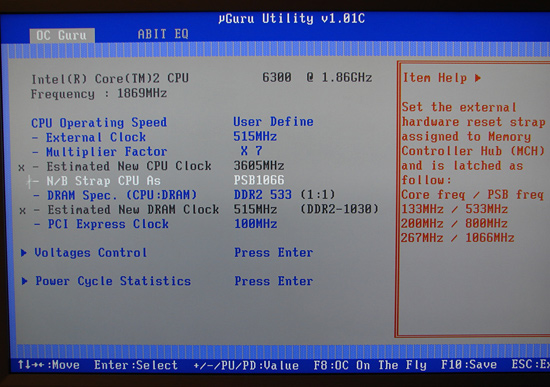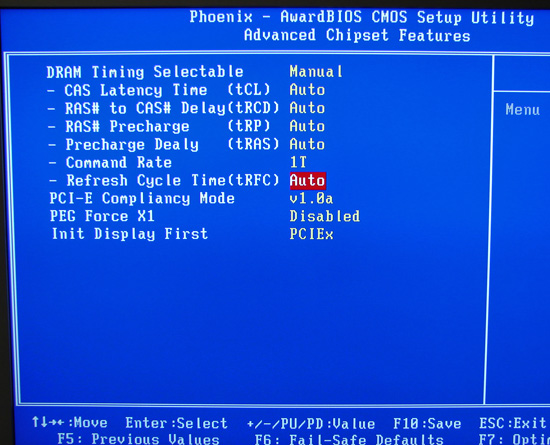Feature Set
abit has equipped this motherboard with a bevy of top end features and it is currently selling in the $219 range. The board features the Realtek ALC888 HD audio codec, Realtek RTL8810SC Gigabit Ethernet controller, dual e-SATA ports via the JMicron JMB363 chipset, and IEEE 1394 Firewire support. The accessory kit contains the basic SATA and IDE cables, external USB/Firewire bracket, and extensive documentation on the motherboard and µGuru functionality. However, abit did not include e-SATA cables and considering the cost of the kit we believe this in an omission.


The BIOS options for the AB9 QuadGT are fairly extensive for a motherboard in this sector, and of course the board features abit's excellent µGuru technology. The voltage options and availability of choices within each option will please the majority of enthusiasts. Besides memory voltage options up to 3.00V, the board also features the ability to change the command rate to 1T. In our initial testing we could not get 1T operation stable at DDR2-800 but were successful at DDR2-667 with a wide variety of Micron D9 based modules. However, we had trouble with several DDR2-667 modules based on Promos and Elpida memory ICs. The performance at DDR2-667 1T was equal to or up to 4% slower in several benchmarks when compared to DDR2-800 2T at the same memory latency timings. We believe abit still has significant tuning to complete to get 1T operating at DDR2-800 in a stable manner.
| abit AB9 QuadGT | |
| Market Segment: | Enthusiast Performance - $219.99 |
| CPU Interface: | Socket T (Socket 775) |
| CPU Support: | LGA775-based Pentium 4, Celeron D, Pentium D, Pentium EE, Core 2 Duo, Core 2 Extreme |
| Chipset: | Intel P965 + ICH8R |
| Bus Speeds: | 133 to 600 in 1MHz increments |
| Northbridge Strap: | CPU, 1066, 800, 533 |
| Memory Speeds: | SPD, 533, 667, 800 |
| PCIe Speeds: | 100 to 200 in 1MHz increments |
| PCI: | Fixed |
| Core Voltage: | Default, Base to 1.9250V in +.0100V increments |
| CPU Clock Multiplier: | Auto, 6x-11x in 1X increments if CPU is unlocked, Core 2 Duo downward unlocked |
| DRAM Voltage: | 1.800V to 3.000V in +.025V increments |
| DRAM- Ref Voltage: | +2%, 0%, -2%, -4% |
| DRAM Timing Control: | SPD, Manual, Auto or Manual for 6 DRAM Timing Options including Command Rate |
| MCH Voltage: | 1.25V to 1.70V in +.05V increments |
| CPU VTT Voltage: | 1.20V, 1.30V, 1.40V, 1.50V |
| ICH Voltage: | 1.05V, 1.10V, 1.15V, 1.20V |
| ICH IO Voltage: | 1.50V to 1.70V in +.05V increments |
| Memory Slots: | Four 240-pin DDR2 DIMM Slots Dual-Channel Configuration Regular Unbuffered Memory to 8GB Total |
| Expansion Slots: | 1 - PCIe x16 1 - PCIe x4 (x16 Physical) 1 - PCIe x1 2 - PCI Slot 2.3 |
| Onboard SATA/RAID: | 6 SATA 3Gbps Ports - RAID 0, 1, 5, 10 - Intel ICH8R 2 e-SATA 3Gbps Port - RAID 0, 1, JBOD - JMicron JMB363 |
| Onboard IDE: | 1 ATA133/100/66 Port (2 drives) - JMicron JMB363 |
| Onboard USB 2.0/IEEE-1394: | 10 USB 2.0 Ports - 4 I/O Panel - 6 via Headers IEEE 1394 - TI TSB43AB22A |
| Onboard LAN: | Realtek RTL8810SC - PCI Express Gigabit Controller |
| Onboard Audio: | Realtek ALC888 8-Channel HD Audio Codec |
| Power Connectors: | ATX 24-pin, 8-pin EATX 12V, 4-pin Molex |
| I/O Panel: | 1 x PS/2 Keyboard 1 x PS/2 Mouse 1 x CMOS Clear Switch 2 x S/PDIF Optical - In and Out 1 x IEEE 1394 Port 2 x e-SATA Port 1 x Audio Panel 1 x RJ45 4 x USB 2.0/1.1 |
| BIOS Revision: | Award 12/11/06 6A79LA1EC-10 |
abit has equipped this motherboard with a bevy of top end features and it is currently selling in the $219 range. The board features the Realtek ALC888 HD audio codec, Realtek RTL8810SC Gigabit Ethernet controller, dual e-SATA ports via the JMicron JMB363 chipset, and IEEE 1394 Firewire support. The accessory kit contains the basic SATA and IDE cables, external USB/Firewire bracket, and extensive documentation on the motherboard and µGuru functionality. However, abit did not include e-SATA cables and considering the cost of the kit we believe this in an omission.


The BIOS options for the AB9 QuadGT are fairly extensive for a motherboard in this sector, and of course the board features abit's excellent µGuru technology. The voltage options and availability of choices within each option will please the majority of enthusiasts. Besides memory voltage options up to 3.00V, the board also features the ability to change the command rate to 1T. In our initial testing we could not get 1T operation stable at DDR2-800 but were successful at DDR2-667 with a wide variety of Micron D9 based modules. However, we had trouble with several DDR2-667 modules based on Promos and Elpida memory ICs. The performance at DDR2-667 1T was equal to or up to 4% slower in several benchmarks when compared to DDR2-800 2T at the same memory latency timings. We believe abit still has significant tuning to complete to get 1T operating at DDR2-800 in a stable manner.










41 Comments
View All Comments
Stele - Monday, January 22, 2007 - link
I second that. Intel has, unfortunately, a reputation for making drastic moves every now and then in a certain technological direction which it feels that everyone should head towards, and hurry - never mind if everyone else does not feel the same way about it, or if that direction is simply not ready for prime time; RDRAM, Itanic, BTX, and now removal of native IDE support stand testimony to that.I can't speak for everyone of course, but JMicron isn't so bad, really, at least from personal experience... a string of systems using P5B Deluxe and P5B-E Plus motherboards have so far behaved quite well during setup and installation. Part of the problem probably lies in how well motherboard manufacturers implement the device in their design and how much effort they put in to make sure they get it right. As for the alternatives to JMicron, it's not too easy to find one that can match the JMB363 in terms of features... PCIe, 2 SATA II-compliant ports, 1 ATA-133 IDE interface in a compact, single-chip solution. Perhaps Silicon Image should step forward and make use of their excellent IP to create such a competitor, but I suspect they're focusing on HDMI right now....